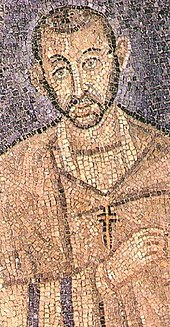Oblates of St. Ambrose and Charles
The Oblates of St. Ambrose and Charles ( Latin : Congregatio Oblatorum Sanctorum Ambrosii et Caroli ), OSC or O.SS.CA , also known under the name " Ambrosianer ", are a congregation of priests and lay people .
history
The supply measures initiated by Archbishop Carlo Borromeo of Milan during the great plague in Milan saved the lives of many people between 1576 and 1578. From this he recognized the need to found a community that should take care of pilgrims, the sick and those in need. The congregation was planned as early as 1570 but was not founded until 1578. Initially, the new religious order was only named after the church father, Ambrosius of Milan . The Archbishop of Milan, Cardinal Federico Borromeo , added that of the founder Charles to her name after he was canonized in 1610. Since then, the order has been called the Oblates of St. Ambrose and Charles . Its head office and parent company was established in Milan. The rules of the order were drawn up over the next few years and promulgated on September 13, 1581. Their religious mandate was not characterized by poverty and monastic life, rather they took on the care and supply of those in need. The religious order was banned and dissolved by Napoleon Bonaparte in 1810 , the restoration only took place in 1854 under Archbishop Bartolomeo Carlo Romilli of Milan.
organization
Currently (as of 2004) the congregation consists of four branches, including:
- 17 Oblate Missionaries (since 1714) with the tasks of popular missionary work ,
- 24 oblate vicars (since 1875) who take on vacant pastors until they are filled by local clergy ,
- 160 oblate priests who are used in dioceses for administration and teaching (since 1931). In the area of Switzerland since the 17th century, the Oblates of St. worked. Ambrosius with schools in Ascona and Pollegio
- 60 oblate laypeople who have taken on care, technical and administrative tasks since 1932.
reputation
With the help of the Jesuits and the oblates he founded, Charles Borromeo succeeded in restoring the prestige of the priesthood. With the World Priests Association of the Oblates of St. Ambrose he carried out the ecclesiastical restoration in the Archdiocese of Milan and the entire ecclesiastical province.
Helvetic College
In 1579, Karl Borromeo founded the Helvetic College to combat Protestantism in Switzerland . The Collegium was a seminary for the Catholic Confederation of Graubünden . In 1568, Pope Pius V allowed the Archbishop of Milan to accept any number of Swiss people into his seminary. The domestic administration was carried out by the Congregation of the Oblates of St. Ambrosius paused. The lectures were given by Jesuits first until the Oblates took over the school. In addition to the scholarship holders, Italian students frequented the seminary, which in its heyday had over a hundred students.
literature
- Lexicon of Saints . Verlagsgruppe Weltbild GmbH, Augsburg 2007, ISBN 3-8289-4980-0
See also
Web links
- Joachim Schäfer: Karl Borromeo . Ecumenical Lexicon of Saints , November 26, 2015.
Individual evidence
- ↑ Joachim Schäfer: Order designations . Ecumenical Lexicon of Saints , accessed on December 1, 2016.
- ^ Friedrich Wilhelm Bautz: Borromäus, Karl (Carlo Borromeo). In: Biographisch-Bibliographisches Kirchenlexikon (BBKL). Volume 1, Bautz, Hamm 1975. 2nd, unchanged edition Hamm 1990, ISBN 3-88309-013-1 , Sp. 708-709.
- ^ Hans Stadler: Collegium Helveticum. In: Historical Lexicon of Switzerland . March 11, 2010 , accessed December 1, 2016 .

